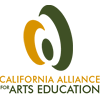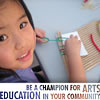Well-Rounded Curriculum in the Spotlight as ESEA Re-Write Gains Momentum
By Heather Noonan, Vice President for Advocacy for the League of American Orchestras and Co-Chair of the ad-hoc National Arts Education Policy Working Group.
How will the next version of the Elementary and Secondary Education Act (ESEA) support access to the arts as part of a well-rounded education for every child? This month the Administration, Congress, and arts education advocates have advanced the conversation. Now is a critical time for arts advocates to engage in the real heart of the debate.
Speaking before the national Arts Education Partnership forum on April 9, US. Secretary of Education Arne Duncan delivered his view, declaring that the arts “can no longer be treated as a frill,” and reported that, during his national listening tour, “almost everywhere I went, I heard people express concern that the curriculum has narrowed, especially in schools that serve disproportionate numbers of disadvantaged students.”
The March 13 Obama Administration blueprint for re-writing ESEA lays out the Department’s view on federal education policy. Three areas of the blueprint emerged in Duncan’s remarks:
- Proposals would allow states to incorporate assessments of subjects beyond English, language arts and math in their accountability systems.
- The current Arts in Education funding program would be merged with other funding areas so that districts, states, and non-profits would apply for competitive grants to support the arts among other eligible non-tested core academic subjects of learning.
- New resources for afterschool and extended day learning could open the door for support for arts education.
These proposals present opportunities, but also concerns, for arts advocates. All three are based on the assumption that state and local leaders would be incentivized to choose the arts when crafting applications to U.S. Department of Education and forming assessment plans. Arts proponents — already hard-pressed to gain support for the arts among state and local policymakers in the wake of NCLB’s math and reading focus ,and anxious about the added emphasis on Science Technology, Engineering and Mathematics (STEM) in the Obama funding and ESEA proposals – are asking: How will the arts gain traction, without stronger federal leadership?
If you look through the 45-page blueprint, you gain a deeper a sense of the major themes that will play out in the upcoming federal debate:
- College and Career-Ready Students
- School Turn-Around Strategies
- Improved Professional Development
- Evidence-Based Instructional Models
To be players in this rapidly-developing policy discussion, the arts education community will need to communicate how the arts advance these broad education goals. While advocates must continue to argue for the arts’ rightful place among core academic subjects accessed by all students, it will not be enough to complain about being pushed to the margins. In other words, asking to put the “STEAM in STEM” – while a memorable catch-phrase – does little to inject the arts into other areas of the broader policy debate.
The good news is that we have the goods to make a convincing case about the impact of the arts on improving education. On the heels of Secretary Duncan’s speech, more than 500 arts advocates took to Capitol Hill for national Arts Advocacy Day, calling for dedicated funding for arts education, improved national research, and annual state reports on the status and condition of all core academic subjects, including the arts.
The chair of the Senate committee charged with drafting the next ESEA says he plans to have a draft bill ready by June and recently hosted a hearing on “Meeting the Needs of the Whole Student.” While completing the new law before the end of the year is unlikely, given the host of other policy priorities in this mid-term election year, early talks on the Hill will lay the foundation for the final bill to come. By weighing in now, and marshaling our best arguments, arts education advocates can and should claim a seat at the policy table.
One Response to “Well-Rounded Curriculum in the Spotlight as ESEA Re-Write Gains Momentum”
Julie Simpson Says:
May 6, 2010
Thanks for this great article, Heather. You raise several important points, including the need for arts advocates to develop an argument that goes beyond complaining about the arts are being sidelined. Instead, we need to focus our efforts on insisting that the arts are considered in a vein similar to that of technology – not simply as another content area (although, there are most definitely discipline-based skills which must be mastered), but rather as a discipline infused into all other content areas in order to enhance and enrich the learning experience. The arts can be viewed in an identical manner… discipline-based practice must occur in order to gain proficiency in the artform; but then, it is most beneficial to construct interdisciplinary curricula with the arts and other subject areas in order to create a whole that is truly greater than the sum of its parts. If, as educators and arts administrators, we are going to promote the 4 C’s of the 21st Century Skills: Communication, Collaboration, Critical Thinking and Creativity, then infusing the arts into other content areas is a must. Only then will the arts be able to contribute as a platform from which we can advance some of the broader education goals which Heather so aptly outlined above.
Julie Simpson
Executive Director, Urban Gateways










